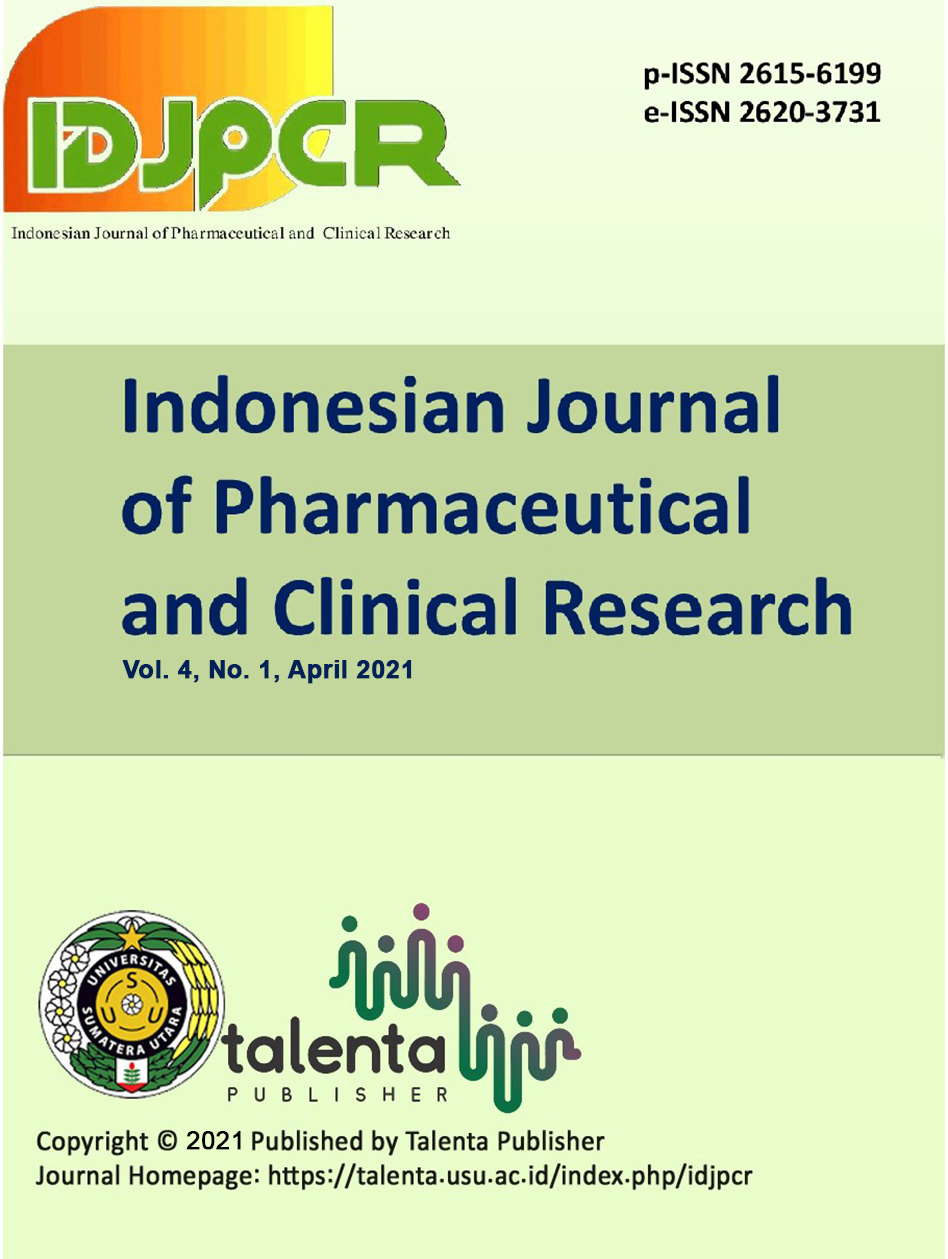Formulation and Evaluation of Skin Anti-aging Nanocream Containing Canola (Brassica napus L.) Oil
DOI:
https://doi.org/10.32734/idjpcr.v4i1.5821Keywords:
canola oil, nanocream, cream, anti-agingAbstract
Canola (Brassica napus L.) oil high in vitamin E is good for skin care. Vitamin E is an effective antioxidant that protects our skin from free radical damage and keeps the skin elasticity, evenness, reduces blemishes, acne scars, and slows down the skin’s aging. This study aimed to formulate canola oil nano cream and find out canola oil nano cream gives a higher anti-aging effect than canola oil cream. Nanocream as anti-aging formulated in four variations of canola oil concentration 2,5%, 5%, 7,5% and 10%. Nanocream was tested IC50, and observed the characteristics and stability. Then, continue to irritation test and anti-aging activity of nanocream compared with cream on the skin of volunteers. The result showed that nanocream of variation canola oil was in a different color and distinctive smell. The preparation was stable in 12 weeks room temperature storage, homogenous, and no phase separation. Particle size was 5882.17 nm, 348.47 nm, 321.16 nm, 318.16 nm initially and increased after 12 weeks. There was no irritation, and anti-aging activity was higher than cream. Canola oil can be formulated as nanocream, stable in 12 weeks storage, and nano cream has higher anti-aging activity than cream.
Downloads
References
. N. Dayan, Skin aging handbook: an integrated approach to biochemistry and product development, William Andrew Inc. United State of America. pp. 22, 58, 150, 236. 2008.
. A.T. Honary, and E. Richter, Biobased lubricants and greases technolgy and products. Canada: Library Of Congress Cataloging Publication Data. pp. 42-43. 2011.
. T. Xuan, G. Gangqiang, T. Minh, T. Quy, and T. Khanh, “An Overview of Chemical Profiles, Antioxidant and Antimicrobial Activities of Commercial Vegetable Edible Oils Marketed in Japan,†Foods, vol. 7, no. 2, p. 21, Feb. 2018.
. M. F. Abdulkarim, S. M. Hameem, G. Z. Abdullah, E. S. Mahdi, M. Chitneni, M. F. Yam, A. Faisal, I. M. Salman, O. Z. Ameer, M. Z. Abdulsattar, M. Basri, and A. M. Noor, “Formulation and characterization of palm oil esters based nano-cream for topical delivery of piroxicam.,†International Journal of Drug Delivery, vol. 2, no. 4, pp. 287–298, Dec. 2010.
. M. Y. Koroleva and E. V. Yurtov, “Nanoemulsions: the properties, methods of preparation and promising applications,†Russian Chemical Reviews, vol. 81, no. 1, pp. 21–43, Jan. 2012.
. E.Y. Yuniwarti, T.R. Saraswati, and E. Kusdiyantini, “Aktivitas antioksidan berbagai minyak edible menggunakan metode DPPH. Buletin Anatomi dan Fisiologi, vol. 3, no.1, pp. 85- 88, 2018.
. A.B. Kananlua, “Preparation of dilpamitate kojic acid nanocrims with a combination of surfactant Tween 80 and propylene glycol using a mixer. Thesis. Faculty of Pharmacy. Universitas Sanata Dharma. Yogyakarta. pp. 40-41. 2016.
. Y. Darwis, N. Zainol, and T. Ming, “Development and characterization of cinnamon leaf oil nanocream for topical application,†Indian Journal of Pharmaceutical Sciences, vol. 77, no. 4, p. 422, 2015.
. R. Dewi, E. Anwar, and Y. K. S, “Uji Stabilitas Fisik Formula Krim yang Mengandung Ekstrak Kacang Kedelai (Glycine max),†Pharmaceutical Sciences and Research, vol. 1, no. 3, pp. 194–208, Dec. 2014.
. Directorate general of drug and food control. Pharmacopoeia of Indonesia. 3rd ed. Ministry of Health of the Republic of Indonesia. Jakarta. pp. 649, 659. 1979.
. Directorate general of drug and food control. Indonesian cosmetics formulary. Ministry of Health of the Republic of Indonesia. Jakarta. pp. 29. 1985.
. P.J. Sinko, Pharmaceutical Physics and Pharmaceutical Sciences. EGC. Jakarta. pp. 647-648. 2006.
. L. Lachman, Lieberman, A. Herbert, Kanig, and L. Joseph. Pharmaceutical industry theory and practice 1. 3rd ed. Universitas Indonesia Press. Jakarta. pp. 1081-1083. 1994.
. Y. Triapriani, Preparation of nanocellulose from empty palm fruit bunches by using acid hydrolysis method. Thesis. Faculty of Math and Science. Universitas Lampung. 2016.
. S.M. Wasitaatmadja, Medical cosmetic science guide. UI Press. Jakarta. pp. 111-112. 1997.
. R. Khattab, C. Rempel, M. Suh, and U. Thiyam, “Quality of Canola Oil Obtained by Conventional and Supercritical Fluid Extraction,†American Journal of Analytical Chemistry, vol. 03, no. 12, pp. 966–976, 2012.
. S.K. Niazi, Handbook of pharmaceutical manufacturing formulations: semisolid products. CRC Press LLC. Florida. pp. 22-23. 2004.
. N.N. Izzati, Diniatik and S.S. Wiranti,â€The antioxidant activity of mangosteen (Garcinia mangostana L.) leaf extract based on the DPPH (2,2Diphenyl-1-phycryl hydrazil) methodâ€, Pharmacy Journal, vol. 9, no. 3, pp. 111-119, 2012.
. A.Martin, J. Swarbrick and A. Cammarata, Physical pharmacy: the basics of physical chemistry in pharmaceutical sciences. 3rd ed. UI Press. Jakarta. pp. 1135, 1144. 1993.
. R.I. Tranggono, and F. Latifah, Handbook of cosmetic science. Gramedia Pustaka Utama. Jakarta. pp. 6-8. 2013.
. T. Mehmood, “Optimization of the canola oil based vitamin E nanoemulsions stabilized by food grade mixed surfactants using response surface methodology,†Food Chemistry, vol. 183, pp. 1–7, Sep. 2015.
. A. Pappas, Nutrition and skin: lessons for anti-aging, beauty and healthy skin. Springer. London. pp. 49, 59. 2011.
. Z. D. Draelos and L. A. Thaman, Eds., “Cosmetic Formulation of Skin Care Products,†Jun. 2005.
Downloads
Published
How to Cite
Issue
Section
License
Copyright (c) 2021 Indonesian Journal of Pharmaceutical and Clinical Research

This work is licensed under a Creative Commons Attribution-ShareAlike 4.0 International License.
The Authors submitting a manuscript do so on the understanding that if accepted for publication, copyright of the article shall be assigned to Indonesian Journal of Pharmaceutical and Clinical Research (IDJPCR) and Faculty of Pharmacy as well as TALENTA Publisher Universitas Sumatera Utara as publisher of the journal.
Copyright encompasses exclusive rights to reproduce and deliver the article in all form and media. The reproduction of any part of this journal, its storage in databases and its transmission by any form or media, will be allowed only with a written permission from Indonesian Journal of Pharmaceutical and Clinical Research (IDJPCR).
The Copyright Transfer Form can be downloaded here.
The copyright form should be signed originally and sent to the Editorial Office in the form of original mail or scanned document.









